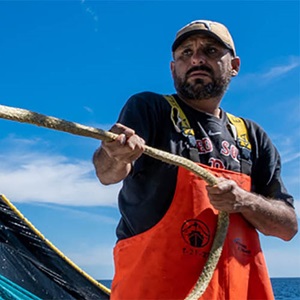A review of the MSC Fisheries Standard Toolbox is underway to ensure that key procedures developed to support fisheries assessments are effective.
The Fisheries Standard Toolbox was developed alongside the MSC Fisheries Standard Version 3, which was published in October 2022. It contains new procedures to support fisheries assessments, including:
- The Evidence Requirements Framework,
- The Benthic Impacts Tool,
- Early application of Section SE,
- and an updated version of the Risk-based Framework.
The review of the Toolbox includes:
- An external evaluation of and substantial revision to the Evidence Requirements Framework
- Changes to the Risk-based Framework
Why is the Toolbox being reviewed?
Stakeholder feedback following the publication of Version 3 of our Standard and the Toolbox highlighted aspects that were unclear, overly complex and not delivering the sustainability outcomes we intended.
We are addressing some of these concerns through the Toolbox review, which aims to reduce the complexity of the fisheries assessment process and ensure performance expectations for fisheries are set at appropriate levels.
The Toolbox review is part of a wider set of changes, now known as the Fisheries Program Revisions, which also includes targeted revisions to key areas of the Standard, Fisheries Certification Process, and other program documents.
Full details of the proposed revisions to the Toolbox, including a version of the Toolbox with track changes and a supporting document summarising the proposed revisions, will be made available when the consultation launches on 10 July.
Read the Terms of Reference for the MSC Fisheries Standard Toolbox ReviewReviewing the Evidence Requirements Framework
The Evidence Requirements Framework provides a method to evaluate the evidence used during a fishery assessment and was a significant new addition to Version 3 of our Standard.
A review of the Evidence Requirements Framework is being carried out by an external panel of fisheries assessment experts, and focuses on the following:
- How information is assessed through the Evidence Requirements Framework, and how to make this process clearer, more efficient and reduce assessment time and costs.
- Performance levels required of fisheries, including thresholds set for independent observation to verify catch data.
- Consistency of language and intent between the Standard and Evidence Requirements Framework.
- Ensuring requirements are appropriate for different fishery types and align with widely used and accepted management best practice.
Proposed changes to the Evidence Requirements Framework
The external review panel has proposed a series of changes to the Evidence Requirements Framework, and to the areas of the Fisheries Standard where the Framework is used for scoring.
The changes include:
Simplification of the Evidence Requirements Framework and modifications to ensure it provides a process for assessors to consider and document the evidence used for scoring, rather than prescribing how scores should be determined.
It now focuses on helping assessors determine whether the information provided during a fishery assessment is adequate.
The requirements for thresholds on catch monitoring and independent monitoring remain but have now been moved from the Framework document into the Fisheries Standard.
Ensuring our requirements for independent monitoring and observation coverage align with global best practice:
A revised threshold is proposed for independent observer and electronic monitoring coverage for fisheries on the high seas. The threshold has been revised to 20 percent (from 30 percent in the original version).
- This was informed by two independent reviews of global monitoring programs. The outcomes highlighted the challenge of setting prescriptive monitoring levels that would be suitable for all fisheries.
- The reviews also emphasised the importance of maintaining distinct and higher requirements for high seas fisheries, as oversight of activities is more difficult and risks are greater, including bycatch and interactions with endangered species.
- We concluded that 30 percent coverage exceeded current practice in many fisheries, whereas 20 percent coverage is widely regarded as a practical minimum for high seas fisheries. It also reflects current efforts by regional fisheries management organisations (RFMOs) to increase observer coverage in fisheries to this level.
- While no single threshold can meet all monitoring needs, 20 percent offers a balanced and science-backed starting point for improving data quality across diverse fishing contexts.
High seas fisheries using pole and line, troll, or handline gears would be exempt from the proposed 20 percent monitoring thresholds.
Fisheries using such gears often lack the space on-board vessels and/or the resources to implement at-sea monitoring programs.
RFMOs typically don’t require these fisheries to use onboard observers or use electronic monitoring systems as they are a more selective method of fishing and generally have low levels of bycatch and few interactions with endangered species.
Importantly, all fisheries, regardless of where they operate or the gears used, must still report catch to management authorities and have a system to independently verify catch data according to the revised requirements.
Changes to scoring guideposts in the Standard where the Evidence Requirements Framework applies.
The proposed changes will ensure cohesion and consistency between the Toolbox and Standard.
- For example, revisions to the scoring guideposts for the shark finning requirements have been proposed to ensure a fins naturally attached (FNA) or non-retention policy is fully implemented and expected to be effective.
- Under the previous version of the Standard, fisheries were only required to demonstrate that these policies are in place, and did not have to show the policies were being complied with.
- The revisions would increase the rigour of our Standard by requiring assessors to determine whether fisheries are complying with the required FNA or non-retention policy.
Reviewing the Risk-Based Framework
The Risk-Based Framework (RBF) is used to assess the environmental impacts of fisheries with limited data.
It is vital the RBF is precautionary; however we have identified aspects where thresholds for assessing a fishery’s impact require recalibration.
Aims of the review
The review of the Risk-based Framework includes the following:
- Ensuring the RBF aligns with the Standard
- Ensuring the RBF is suitably precautionary by addressing technical issues and recalibrating thresholds
- Ensuring the RBF can be applied efficiently
Proposed changes to the Risk-based Framework
A series of proposed changes to the Risk-based Framework have been developed (see below). This followed a review carried out by the MSC, with input from independent consultants.
Clarified use of the RBF in assessing Principle 2
Guidance will be added to the Fisheries Standard Toolbox to clarify how management performance indicators should be assessed when the RBF has been used.
New risk assessment tool
An optional ‘Residual Risk Assessment’ tool has been introduced, which can be used to adjust a fishery’s scores for certain species that have been scored using a Productivity Susceptibility Analysis (PSA).
Streamlined engagement process during assessments
Assessors will be required to highlight information gaps or include draft scores derived through the RBF at an earlier stage of the assessment process (i.e. inclusion in the Announcement Comment Draft Report).
This will help stakeholders provide feedback on the use of the Risk-based Framework more easily and earlier on.
There will also be more flexibility in how assessors can engage stakeholders and how stakeholders can provide input on the use of the RBF in scoring a fishery.
Proposed revisions
For more information, you can download a summary of the proposed revisions to the Fisheries Standard Toolbox and associated areas of the Standard.You can also download draft versions of the Toolbox and Standard. These documents enable comparison between the proposed revisions and the original requirements.
Take part in the review
A public consultation on the proposed revisions to the Toolbox and associated areas of the Standard was held between 10 July and 10 September.
The feedback received will be carefully reviewed and used to further improve the revisions, alongside pilot tests and impact assessments, and the wider revisions made as part of the Fisheries Program Revisions.
All stakeholders and partners will have an opportunity to review the final proposals. We anticipate this next stage of consultation will take place in mid-2026.
Please contact [email protected] if you have any questions about the Toolbox Review and proposed changes.
Watch our webinar
In July 2025, we held two webinars across different time-zones to discuss the proposed changes to the Fisheries Standard Toolbox and associated areas of the Standard.
Watch the recording below to find out more. A summary of both Q&A sessions is also available.
MSC Fisheries Standard V3: Consultation on revisions to the Fisheries Standard Toolbox
Research informing proposed revisions to the Toolbox and Standard
Several key studies have informed the proposed revisions to the Toolbox and Standard:
- A review of optimal levels of observer coverage, conducted by MRAG UK (2021)
- A global review of current practices in independent verification and observer coverage, also carried out by MRAG UK (2025)
- An analysis of information available on fisheries compliance, undertaken by Geir Hønneland (2025)
These studies provided valuable insights and helped ensure that proposals are grounded in the latest information on widely adopted best practice.





